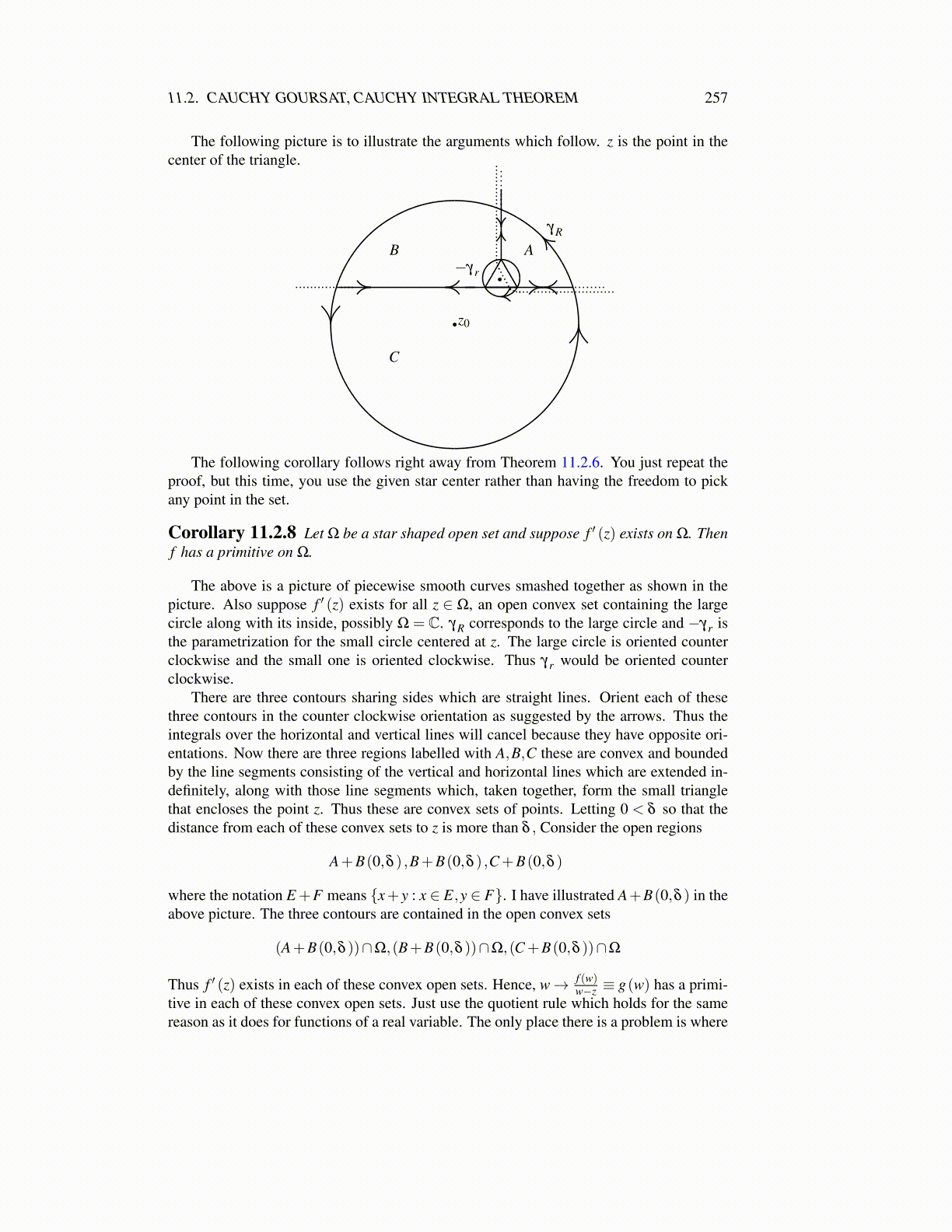
11.2. CAUCHY GOURSAT, CAUCHY INTEGRAL THEOREM 257
=1
2πi
∫γR
∞
∑k=0
f (w)(z− z0)k
(w− z0)k+1 dw
The series converges uniformly by the Weierstrass M test and also absolutely because∣∣∣∣∣ f (w)(z− z0)k
(w− z0)k+1
∣∣∣∣∣≤MR̃k(
R̃+δ)k+1
where M is as large as the maximum value of | f | on the compact set D(z0,R) . It followsfrom Theorem 11.1.6, that one can interchange the integral with the sum. This yields
f (z) =∞
∑k=0
(1
2πi
∫γR
f (w)
(w− z0)k+1 dw
)(z− z0)
k
Then a use of Theorem 11.1.6 again and the Weierstrass M test shows the series convergesuniformly and absolutely for all |z− z0| ≤ R̃. Corollary 8.2.2 shows that
12πi
∫γR
f (w)
(w− z0)k+1 dw =
f (k) (z0)
k!.
In summary, this shows that for f : U → C for U an open set in C, it follows thatif f ′ exists on U then near z0 ∈ U, f is given by a power series and has infinitely manyderivatives. As to primitives, if F is one, then F ′ = f and so F and hence f have allderivatives. Thus there is no such thing in this subject as a primitive of a function which isonly continuous. It also shows that such differentiable functions of a complex variable arereally glorified polynomials and you find eventually that in every way they behave just likepolynomials. This was partially observed earlier in the material on power series. The aboveargument also shows that the power series for a function will converge on increasing disksuntil the circle bounding the disk encounters a point where the derivative of the functiondoes not exist. This follows from Theorem 8.1.3 and Corollary 8.2.2. This completes thediscussion of power series and shows that they are only understandable in the complexplane.
The two kinds of functions of greatest interest in algebra are polynomials and rationalfunctions. The two kinds of interest in complex analysis are analytic functions and mero-morphic functions, the latter being a generalization of rational functions just as analyticfunctions are generalizations of polynomials.
There was nothing in the above argument for the Cauchy integral formula which de-pended on γ∗R being a circle.
Corollary 11.2.12 Suppose γ∗ is a C1 closed curve as described above in Definition11.1.2. Assume it divides the plane into two open sets such that γ∗ is the boundary of each,the inside being the bounded open set. Assume γ∗ along with its inside is contained in aconvex open set on which a function f is differentiable. Then the conclusion of Theorem11.2.9 is still valid for a suitable orientation of γ∗. This orientation will be called thecounter clockwise orientation.
Proof: Letting z be the point on the inside of γ∗, consider a small circle as shown abovecontaining z. Orient this small circle in the clockwise direction. Obtain the four contoursas in the proof of Theorem 11.2.9 by extending the straight lines till they intersect γ∗ for